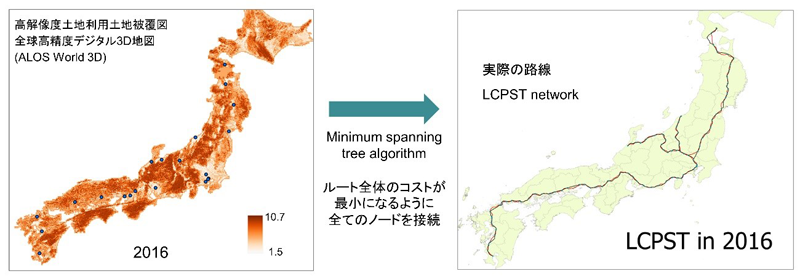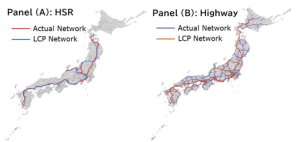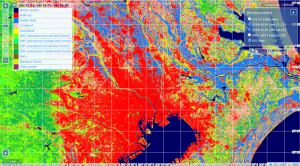

Applications
2023.11.29 Wed
The Use of Earth Observation Satellite Data in the Humanities and Social Sciences (1)
Since the outbreak of COVID-19, JAXA has been conducting contract research using Earth observation data by experts in socioeconomics and other fields. We aim to create new economic value through the multiple analysis of economic and satellite data, including the evaluation of various economic activities.
Therefore, we will introduce the achievements of the research that has been conducted so far in this series. The first article is about the economic impact of high-speed rail using satellite data, a research project with the Managi Laboratory of the Graduate School of Engineering, Kyushu University.
Double-edged trains: Economic outcomes and regional disparity of high-speed railways
Authors: Sunbin Yoo1, Junya Kumagai2, Kohei Kawasaki1, Sungwan Hong3, Bingqi Zhang1, Takuya Shimamura1, Shunsuke Managi1 (1 Kyushu University, Faculty of Engineering, 2 Fukuoka University, Faculty of Economics, 3 Pennsylvania State University, Department of Economics)
Journal: Transport Policy
DOI: https://doi.org/10.1016/j.tranpol.2023.01.016
Publication Month: August 2023
URL: https://www.sciencedirect.com/science/article/pii/S0967070X23000227
– Introduction –
Since the inauguration of the Shinkansen in Japan, high-speed rail has developed in various countries around the world. Plans for high-speed rail development are also underway in Southeast Asia, South America, and the United States. Expansion of high-speed rail suggests developmental benefits for cities in terms of land values, income, industrial structure, and employment. In regions where high-speed rail development is planned, it is important to fully understand and make decisions based on these positive effects. However, high-speed rail can also exacerbate economic regional disparities, a potential “negative effect”. This article investigates the economic effects and regional disparities of high-speed rail using a virtual Shinkansen network based on “Global Digital Elevation Data” and “Land Use Land Cover Map” obtained from JAXA’s land observation technology satellites “Daichi” (ALOS) and “Daichi 2” (ALOS-2).
This research was published in the Transportation Policy journal in March 2023.

(1) Constructing Market Access
Since high-speed rail tends to open primarily in cities with large populations and economies, addressing endogeneity is crucial in identifying the causal relationship between high-speed rail and economic effects. Many existing studies use the Difference-in-Differences (DID) method, measuring the opening effects by comparing regions where lines have opened (treatment group) to others (control group). However, it has been noted that regions classified as control groups can also benefit from the opening of lines in nearby areas, causing bias in estimates.
Considering these issues, this study utilized the “Market Access (MA)” index formulated by Donaldson and Hornbeck (2016). MA, which represents “demand considering geographical location,” is an indicator of market potential. It was calculated by multiplying the population of each municipality with the travel time-based costs between municipalities. This index assesses the indirect effects of high-speed rail openings on other regions. To address the endogeneity of the interrelation between route placement and economic factors, the instrumental variable method was used, employing MA derived from a virtual Shinkansen network constructed to minimize construction costs based on geographic conditions. Figure 2 shows the increase rate of MA in all Japanese municipalities from 1983 to 2020, with darker colors indicating greater increases in MA, particularly in and around regions where the Shinkansen was developed.

(2) Land Value Increase Effects and Regional Differences in Shinkansen Development
This study estimated the economic effects caused by the increase in MA due to the high-speed rail network, using land value as the primary dependent variable. Regression analysis was conducted, including fixed effects for prefectures, fiscal years, municipalities, and geographic locations. Economic effects were estimated for four regional categories (“Tokyo,” “Three Major Metropolitan Areas,” “Regional Central Cities,” and “Other Regions”) and the national average. The results showed that a 1% increase in MA led to a 0.176% increase in land value nationally. Regionally, significant effects were observed only in Tokyo, the three major metropolitan areas, and regional central cities, with no significant effects in other regions. Thus, the study demonstrated regional disparities in the economic effects of Shinkansen development.
(3) Counterfactual Virtual Simulation
Finally, the economic effects of future Shinkansen development plans (Linear Chuo Shinkansen, West Kyushu, Hokuriku, Hokkaido Shinkansen) were assessed through counterfactual virtual simulations. It was shown that the Linear Chuo Shinkansen would bring significant effects to Tokyo and the three major metropolitan areas, but not to other regions. As for various Shinkansen line extensions in rural areas, it was found that they would lead to land value increases in regional central city areas. These findings suggest that future Shinkansen development may only bring economic benefits to metropolitan areas, potentially widening regional disparities.

(Left: Linear Chuo Shinkansen, Middle: Regional line expansions, Right: Both plans)
(4) Key Findings from This Study
This study investigated the economic effects and regional disparities associated with the expansion of high-speed rail (Shinkansen) in Japan, utilizing the high accuracy and resolution of “Daichi” in representing terrain and land use. The main insights obtained are as follows:
- High-speed rail increases land values on a national average.
- The effect of high-speed rail development on land values is biased towards major cities.
- Future railway development plans in Japan may exacerbate economic disparities between urban areas and other regions.
By addressing the endogeneity issues highlighted in previous studies and analyzing the direct and indirect effects of national-scale high-speed rail expansion, this research is significant in understanding the positive and negative impacts of high-speed rail. It is expected to be useful for decision-making in future high-speed rail development plans worldwide. Additionally, depending on the nature of the data acquired, this method could be used to analyze impacts on finer industry structures and environmental indicators, with further results anticipated in the future.
Search by Year
Search by Categories
Tags
-
#Earthquake
-
#Land
-
#Satellite Data
-
#Aerosol
-
#Public Health
-
#GCOM-C
-
#Sea
-
#Atmosphere
-
#Ice
-
#Today's Earth
-
#Flood
-
#Water Cycle
-
#AW3D
-
#G-Portal
-
#EarthCARE
-
#Volcano
-
#Agriculture
-
#Himawari
-
#GHG
-
#GPM
-
#GOSAT
-
#Simulation
-
#GCOM-W
-
#Drought
-
#Fire
-
#Forest
-
#Cooperation
-
#Precipitation
-
#Typhoon
-
#DPR
-
#NEXRA
-
#ALOS
-
#GSMaP
-
#Climate Change
-
#Carbon Cycle
-
#API
-
#Humanities Sociology
-
#AMSR
-
#Land Use Land Cover
-
#Environmental issues
-
#Quick Report
Related Resources
Related Tags
Applications Related Articles
-
 Applications 2024.01.15 Mon The Use of Earth Observation Satellite Data in the Humanities and Social Sciences (2)
Applications 2024.01.15 Mon The Use of Earth Observation Satellite Data in the Humanities and Social Sciences (2) -
 Applications 2023.08.04 Fri Contribution to SDGs Goal 6 “Clean Water and Sanitation”
Applications 2023.08.04 Fri Contribution to SDGs Goal 6 “Clean Water and Sanitation” -
 Applications 2023.07.10 Mon Contribution to SDGs Goal 15 “Life on Land”
Applications 2023.07.10 Mon Contribution to SDGs Goal 15 “Life on Land” -
 Applications 2023.06.15 Thu Contribution to SDGs Goal 11 “Sustainable cities and communities”
Applications 2023.06.15 Thu Contribution to SDGs Goal 11 “Sustainable cities and communities”

















